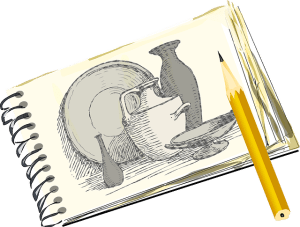I’ve gotten through the first ten lessons of You Can Draw In 30 Days, so I thought I’d show some highlights. Unfortunately my computer refuses to talk to my scanner (or perhaps vice-versa) so I have photographs, which are really not the optimal way to present drawings. Also WP apparently doesn’t allow captioned photos to share a line, so it’s going to be a tall post.

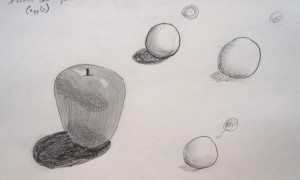
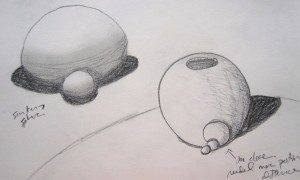
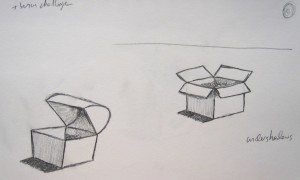
Midstream materials report: I’ve been using drawing pencils I’d purchased some time ago, Staedtler Mars Lumographs. The images above (from lessons 1-5) were drawn with a 4B and those below (6-10) with a 2B. I like the variety of shades of the 4B but prefer how much longer the 2B keeps its point, so I plan to try out a 3B to see if it’s a good compromise.
I started out with a Paper Mate White Pearl eraser, which worked okay (it’s perfect on the rougher/cheaper paper of Games Magazine, by the way), but bought some others at the art store to try, along with some blending stumps, though I haven’t used those much. The Faber-Castell PVC-Free eraser was okay, but kind of plasticky. I’ve been very happy with the Staedtler Mars Plastic, though. It erases really well. Of course it’s probably designed to work well with my Staedtler pencils. I also have a Prismacolor Kneaded Rubber eraser, but I haven’t used it yet. I’ll probably try to preserve it for fine erasing and use the Staedtler for anything that doesn’t require precision.
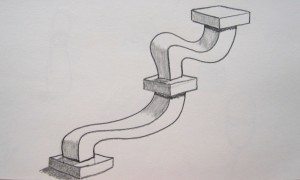
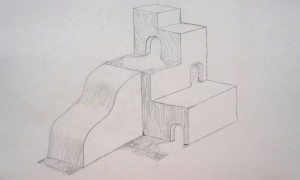
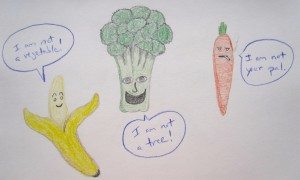
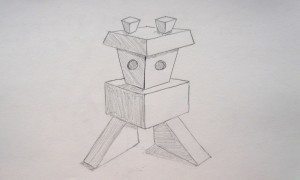
The vegetables were drawn with plain old Crayola Twistables colored pencils, which are terrific to get some variety of color without so much it that becomes paralyzing. This set has red, red-orange, orange, yellow, yellow-green, green, sky blue, blue, violet, light brown, brown, and black. I have a book called “Draw Cute Animals in Colored Pencil” coming soon, so they will get more use.
When I made my felted pencil bag I thought it was probably overkill size-wise, but with 16 pencils, 2 erasers, 2 stumps and a stump cleaning paddle, it’s pretty well full.
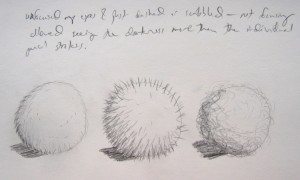
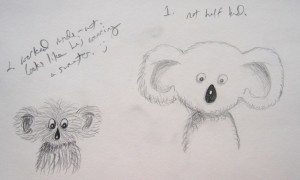
I spent a total of 22 drawing sessions on those ten lessons (including one for the “pretest”), plus 5 sidetracks in the midst of them (and 9 sessions prior to starting the book). At the present rate it’ll be 30 weeks rather than 30 days; that’s fine, I’m learning patience in addition to drawing. Originally I thought a year of drawing might be adequate to get me where I wanted to be, but now I’ll be pleased if it’s merely two years. I’m certainly much more confident than I was, and (I think) also much better – or at least my quality is more reliable. My approach is different and in particular more measured. However, a year just isn’t a long time when it comes to learning a new skill of any depth (duh). After I finish this book I’ll have a lot of work left to learn shading, which is addressed but not at all thoroughly, and facial expressions, which certainly aren’t part of the curriculum. Shading in particular could easily take another 30 weeks to feel confident about.
I think Lesson 7’s bonus challenge (crazy geometric buildings) and the warmup to Lesson 8 (fuzzy, spiky, and wooly balls) were my favorite parts of 1-10, the former because it felt like I was successfully drawing something “real,” and the latter because I thought they turned out really well.
I’ve improved enough that I don’t have to force myself to continue. I regularly have trouble fitting drawing into my day, but it’s rewarding even at the frequency with which I do it. One realization I had at about lesson 8, seeing my husband drawing with friends, is that my lack of drawing skills was a hindrance to me enjoying the activity (in contrast to, say, my lack of bowling skills), and I certainly don’t have to be Rembrandt to get past that problem. I don’t know that I’m quite there yet – I’m still pretty self-conscious about the act of drawing – but it shouldn’t be long.
